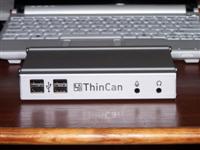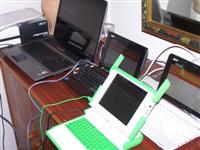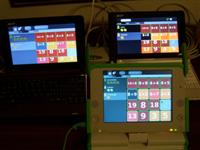We recently held a olpc / LTSP presentation in Vienna, which gave us the opportunity to be experimental and check the wonderful world of using Sugar on various platforms via LTSP. We hooked up 2 Acer Aspire One netbooks, a Thin Client (Artec), a laptop acting as LTSP and ejabberd server, along with 2 traditional XOs.
Before going into the details of the experiment some explanation is due. LTSP stands for Linux Terminal Server Project, and refers to the use of a mainframe like infrastructure, where minimal systems without hardrives and little CPU and RAM can be used as diskless terminals.
The idea is that everything runs from the server, with the client netbooting the environment and using the little RAM and CPU it has to load the kernel and connect its display session to the server.
Usually older computers (Pentium 200hz+ with 64 MB RAM) are re-used in this way, though there are various dedicated thin terminals that are mobile phone sized and are highly energy efficient. LTSP terminals usually have no moving parts, making them hard to break.
Whereas the XO, and rightly so, has been marketed as the guerrilla educational device for the 3rd world, it is a little tied in with a specific company and a specific set of hardware. Sugar on the other hand is not, and in my view the more hardware can run sugar natively and flawlessly, the closer we get to a solution that can really feed the masses.
As the politics of OLPC grow and change, such as dropping Sugar support, or moving to Windows (these are just speculations), Sugar's growth and deployment should not be affected. If anything it gives Sugar and Sugar Labs a firm grounding its its ability to run on multiple systems and scenarios.
In our presentation case, for a mobile server, we used a dual core 1.8ghz with 2 gigs of RAM. Setting up the server on the laptop was pretty straight forward, and involved installing LTSP on top of a base Ubuntu system, and then adding Sugar sessions for all newly created users.
One can choose other sessions of course, but our interest was to test collaboration on all the machines, in which case Sugar was our environment of choice, and the login session for all our users. Installing ejabberd on the ltsp server was the only requirement for sharing across all machines. I followed the instructions as layed out on the laptop.org wikipedia and nubae.com site.
There are still some issues installing ejabberd, such as permissions of the /etc directory, but it has generally become much simpler to install for anyone. Without ejabberd the machines did see each other via xmpp-local, including seeing shared activities, but they tended to fall of the network neighborhood. With ejabberd the machines were visible continuously and were very responsive to connections.
For testing purposes we tried sharing chat across all the machines, which worked flawlessly. The applications in general seemed to load much faster than with the xo hardware, both on the thin can and the acer ones. It was nice to see that a dual core laptop with 2 gigs of ram was more than happy to serve 6 thin terminals at once. This makes the perfect mobile school, with all the machinery fitting into one backpack!
The laptop server was set up to get wireless internet, and then hand out LTSP through the wired interface, using a gigabit switch as a connector. One of the things that still requires a lot of work, and perhaps this is due to using Ubuntu, is getting all the activities to work.
I tested various activities like puzzle slider and jigsaw puzzle, which just left the activity icon cursor flashing on the screen and eventually fell back to the main screen. Another problem was that turning off or restarting the session was nonreactive.
Also many, of the items in the control panel either crashed sugar out completely (date/time) or didn't work. These problems have recently been turned into bug reports, so we hope by the next release of Ubuntu, the environment works as it should.
LTSP and sugar are a great combination and much wished for in schools in the developing and developed world. We will talk a little more about the advantages of LTSP, Sugar and scaling using LTSP-Cluster, as well as wireless LTSP and Fat clients in another article.
David van Assche is an education technologist, helping to implement both pedagogical solutions for IT, and migrating systems from Windows to Linux. You can find his blog at nubae.com





Were the XOs running Sugar natively and collaborating over ejabberd or did you somehow netboot the XOs into thin clients? The XO does not have a PXEclient, so pxebooting is out of the question...
The XOs were connected via the ejabberd server located on the LTSP server (which is why we mentioned traditional XOs.) There was no need to load LTSP on these machines, though it could be done via a usb stick containing a bootstrap and kernel that loads just the wireless drivers necessary for connecting. Of course in this manner, bandwidth would probably be insufficient to get a decent connection. The point here really was to show that be it thin or fat client, the computers all collaborated via sugar on different hardware environments very well.
Sugar on Aspire One - that is a way to go! OLPC definitely has to get rid of any hardware of its own, otherwise, it will not survive.
While I agree that OLPC can't be a pure hardware play, I don't think dropping its hardware is a solution. The XO is a great chunk of engineering that seems surprisingly well-suited to its intended environment (especially when one considers the rest of the deployment process for OLPC). I do think that tackling - or at least supporting and enabling - thin clients to run sugar and collaborate seamlessly with OLPCs is a great idea.
Right now, IMHO, the hardware of the XO is a clearer "sell" than its software. If that flips, supporting thin client architectures will help OLPC capture markets where thin clients work well. However, I don't think that alone it's a solid business or education plan.
Its not really a question of replacing the XO hardware, but rather expanding to all possible markets. Lets face it... the XO is by no means fast or lacking in hardware problems, and the political issues surrounding the company dont really bring too many smiles. By porting sugar to other platforms and distros we can increase the sugar using userbase 100 fold, not to mention developer bases. The ease of management with an LTSP server, along with its easy deployment in existing computer labs is a central driving point. LTSP deployments have so far been far more successful than Xo deployments, and they count in the many millions world wide. The main reason for this is how easy it is to customise, whether u want netbooks that wirelessly connect via fatclient, and synch when they are back in the lan environment, or you want to use hardware that is under $100 and has total roaming profile capabilities. But in the end its an education project we are talking about I hope, not a laptop project... Sugar is the heart of it all...
great job!
Even whithout knowing the root password of my daughters xo -in my country xo's root password is secret for security concerns- I could manage remote desktop via rdp to Windows and Linux, both with an xo1 and a ten year old pc as terminals to a rdpserver. In the case of WindowsXP patched as multiuser terminal server there is a legal issue.
But that's not the point. Sugar is excellent on itself, the xo is excellent. A Sugar install works as thin client, an xo with Sugar is an excellent learning tool and a thinstation too for running other s.o. and programms that can't run on xo h.w.
Sugar itself should be present in Terminal server s.w. for educational purposes. Sugar is more than Sugar and the xo is more than an xo.
I could not believe how many open windows and programms I had open on the xo on a remote season and thought there would be a crash but I really wasn't working on the xo, I was remote working on the server.